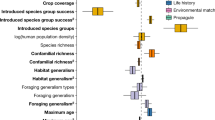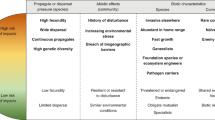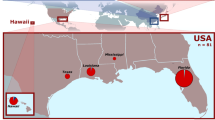Abstract
A major component of human-induced global change is the deliberate or accidental translocation of species from their native ranges to alien environments1,2, where they may cause substantial environmental and economic damage3,4. Thus we need to understand why some introductions succeed while others fail. Successful introductions tend to be concentrated in certain regions2, especially islands and the temperate zone, suggesting that species-rich mainland and tropical locations are harder to invade because of greater biotic resistance1,5,6,7,8,9. However, this pattern could also reflect variation in the suitability of the abiotic environment at introduction locations for the species introduced3,9,10,11, coupled with known confounding effects of nonrandom selection of species and locations for introduction8,12,13,14. Here, we test these alternative hypotheses using a global data set of historical bird introductions, employing a statistical framework that accounts for differences among species and regions in terms of introduction success. By removing these confounding effects, we show that the pattern of avian introduction success is not consistent with the biotic resistance hypothesis. Instead, success depends on the suitability of the abiotic environment for the exotic species at the introduction site.
This is a preview of subscription content, access via your institution
Access options
Subscribe to this journal
Receive 51 print issues and online access
$199.00 per year
only $3.90 per issue
Buy this article
- Purchase on Springer Link
- Instant access to full article PDF
Prices may be subject to local taxes which are calculated during checkout
Similar content being viewed by others
References
Elton, C. The Ecology of Invasions by Animals and Plants (Methuen, London, 1958).
Vitousek, P. M., D'Antonio, C. M., Loope, L. L., Rejmánek, M. & Westbrooks, R. Introduced species: a significant component of human-caused global change. NZ J. Ecol. 21, 1–16 (1997).
Williamson, M. Biological Invasions (Chapman & Hall, London, 1996).
Mack, R. N. et al. Biotic invasions: causes, epidemiology, global consequences, and control. Ecol. Applic. 10, 689–710 (2000).
Pimm, S. L. in Biological Invasions, a Global Perspective (eds Drake, J. et al.) 351–367 (Wiley, Chichester, UK, 1989).
Simberloff, D. in Biological Invasions, a Global Perspective (eds Drake, J. et al.) 61–75 (Wiley, Chichester, UK, 1989).
Case, T. J. Invasion resistance, species build up, and community collapse in metapopulation models with inter-species competition. Biol. J. Linn. Soc. 42, 239–266 (1991).
Rejmánek, M. in Biodiversity and Ecosystem Processes in Tropical Forests (eds Orians, G. H., Dirzo, R. & Cushman, J. H.) 153–172 (Springer, Berlin, 1996).
Holdgate, M. W. Summary and conclusions: characteristics and consequences of biological invasions. Phil. Trans. R. Soc. Lond. B 314, 733–742 (1986).
Newsome, A. E. & Noble, I. R. in Ecology of Biological Invasions (eds Groves, R. H. & Burdon, J. J.) 1–20 (Cambridge Univ. Press, Cambridge, 1986).
Brown, J. H. in Biological Invasions, a Global Perspective (eds Drake, J. A. et al.) 85–109 (Wiley, Chichester, UK, 1989).
Crawley, M. J. The population biology of invaders. Phil. Trans. R. Soc. Lond. B 314, 711–731 (1986).
Londsdale, W. M. Global patterns of plant invasions and the concept of invasibility. Ecology 80, 1522–1536 (1999).
Blackburn, T. M. & Duncan, R. P. Establishment patterns of exotic birds are constrained by non-random patterns in introduction. J. Biogeogr. (in the press).
Harvey, P. H. & Pagel, M. D. The Comparative Method in Evolutionary Biology (Oxford Univ. Press, Oxford, 1991).
Case, T. J. Global patterns in the establishment and distribution of exotic birds. Biol. Conserv. 78, 69–96 (1996).
Sol, D. Are islands more susceptible to be invaded than continents? Birds say no. Ecography 23, 687–692 (2000).
Crawley, M. J., Harvey, P. H. & Purvis, A. in Plant Life Histories: Ecology, Phylogeny and Evolution (eds Silvertown, J., Franco, M. & Harper, J. L.) 36–52 (Cambridge Univ. Press, Cambridge, 1997).
Williamson, M. & Brown, K. C. The analysis and modelling of British invasions. Phil. Trans. R. Soc. Lond. B 314, 505–522 (1986).
Brown, J. H. On the relationship between abundance and distribution of species. Am. Nat. 124, 255–279 (1984).
Gaston, K. J. Rarity 117–124 (Chapman & Hall, London, 1994).
Duncan, R. P., Bomford, M., Forsyth, D. M. & Conibear, L. High predictability in introduction outcomes and the geographical range size of introduced Australian birds: a role for climate. J. Anim. Ecol. 70, 621–632 (2001).
Davis, A. J., Jenkinson, L. S., Lawton, J. H., Shorrocks, B. & Wood, S. Making mistakes when predicting shifts in species range in response to global warming. Nature 391, 783–786 (1998).
Hodkinson, I. D. Species response to global environmental change or why ecophysiological models are important: a reply to Davis et al. J. Anim. Ecol. 68, 1259–1262 (1999).
Lawton, J. H. & Brown, K. C. The population and community ecology of invading insects. Phil. Trans. R. Soc. Lond. B 314, 606–617 (1986).
Crawley, M. J. in Colonization, Succession and Stability: 26th Symposium of the British Ecological Society (eds Gray, A. J., Crawley, M. J. & Edwards, P. J.) 429–453 (Blackwell Scientific, Oxford, 1987).
Ehrlich, P. R. in Biological Invasions, a Global Perspective (eds Drake, J. A. et al.) 315–328 (Wiley, Chichester, UK, 1989).
Smith, C. S., Lonsdale, W. M. & Fortune, J. When to ignore advice: invasion predictions and decision theory. Biol. Invas. 1, 89–96 (1999).
Littell, R. C., Milliken, G. A., Stroup, W. W. & Wolfinger, R. D. SAS System for Mixed Models (SAS Institute, Cary, North Carolina, 1996).
Goldstein, H. Multilevel Statistical Models (Edward Arnold, London, 1995).
Acknowledgements
We thank J. Baker, J. Bale, J. Buonaccorsi, C. Frampton and R. Kinnersley for comments on the manuscript, and the University of Birmingham for funding assistance.
Author information
Authors and Affiliations
Corresponding author
Supplementary information
Rights and permissions
About this article
Cite this article
Blackburn, T., Duncan, R. Determinants of establishment success in introduced birds. Nature 414, 195–197 (2001). https://doi.org/10.1038/35102557
Received:
Accepted:
Issue Date:
DOI: https://doi.org/10.1038/35102557
This article is cited by
-
Biogeography of Beringian fishes after the molecular revolution and into the post-genomics era
Reviews in Fish Biology and Fisheries (2024)
-
Putting plasticity into practice for effective conservation actions under climate change
Nature Climate Change (2023)
-
Assessment of the occurrence and abundance of an exotic zooplankton species (Kellicottia bostiniensis) across a neotropical wetland over 12 years
Limnology (2023)
-
Wildlife trade and the establishment of invasive alien species in Indonesia: management, policy, and regulation of the commercial sale of songbirds
Biological Invasions (2022)
-
Global invasibility potential of the shrub Baccharis drancunculifolia
Brazilian Journal of Botany (2022)
Comments
By submitting a comment you agree to abide by our Terms and Community Guidelines. If you find something abusive or that does not comply with our terms or guidelines please flag it as inappropriate.



